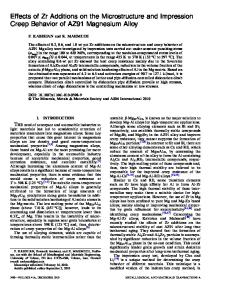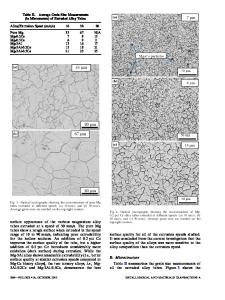Microstructure and mechanical properties of Si and Sb added AZ91 magnesium alloy
- PDF / 1,126,529 Bytes
- 9 Pages / 612 x 792 pts (letter) Page_size
- 35 Downloads / 334 Views
I. INTRODUCTION
MAGNESIUM alloys have been widely used in automobile, aerospace, and electronic industries because of their desirable combination of properties such as low-density high specific strength and specific stiffness, improved damping and electromagnetic shielding capacities, excellent machinability, and good castability.[1,2] These alloys not only offer weight reduction potential when used as structural material in transportation vehicles but also improve the fuel economy and emission regardless of the propulsion system used. During the past decade, the use of magnesium alloy castings in the automobile industry has increased at an impressive rate. AZ91 alloy, which contains 9Al-1Zn-0.2Mn, is the most widely and commercially used Mg alloy system in the automotive industry. Among the Mg alloy components used in transport industries, 90 pct are made from AZ91 alloy.[3] Even though this alloy provides a wide range of room-temperature mechanical properties, it does not exhibit good creep resistance. To overcome this problem, alloys containing less aluminum Mg-Al-RE (AE) Mg-Al-Si (AS) systems have been developed, and they have exhibited improved high-temperature properties and are used in high-temperature applications.[4] The second phases such as MgRE and Mg2Si present in AE and AS alloys, respectively, hinder the grain boundary movement and thereby improve the creep properties. However, AS alloys offer only borderline improvement in creep resistance, whereas AE alloys have cost disadvantages due to costly RE addition.[4] Moreover, these alloys are inferior in castability compared to AZ91. Thus, their usage is restricted in high integrity cast components. In the mean time, researchers have started working to develop Mg alloys that provide high creep resistance. Many experimental alloy systems such as Mg-AlCa, Mg-Zn-Al-Ca, and Mg-Al-Ca have been developed. However, these alloys are not commercialized so far because of their poor die castability. In the 1990s, work was initiated to A. SRINIVASAN, Senior Research Fellow, U.T.S. PILLAI, Scientist, and B.C. PAI, Director Grade Scientist, are with the Metal Processing Division, Regional Research Laboratory (CSIR), Trivandrum - 695 019, Kerala State, India. Contact e-mail: [email protected] or [email protected] Manuscript submitted September 14, 2004. METALLURGICAL AND MATERIALS TRANSACTIONS A
modify the microstructure of the AZ91 alloy by introducing thermally-stable intermetallics through addition of alloying elements to improve high-temperature properties.[5] Surface active elements such as Ca, Bi, and Sb are added to AZ91 alloy to improve creep resistance. Wang et al.[6] has investigated the effect of Ca addition into AZ91 alloy and has found that the Ca addition has refined the microstructure and reduced the quantity of Mg17Al12 phase by forming a new Al2Ca phase. The Ca addition has also reduced the ambient temperature properties because of the fact that the Al2Ca phase has low strength compared to Mg17Al12 at room temperature but confers to the elev
Data Loading...











